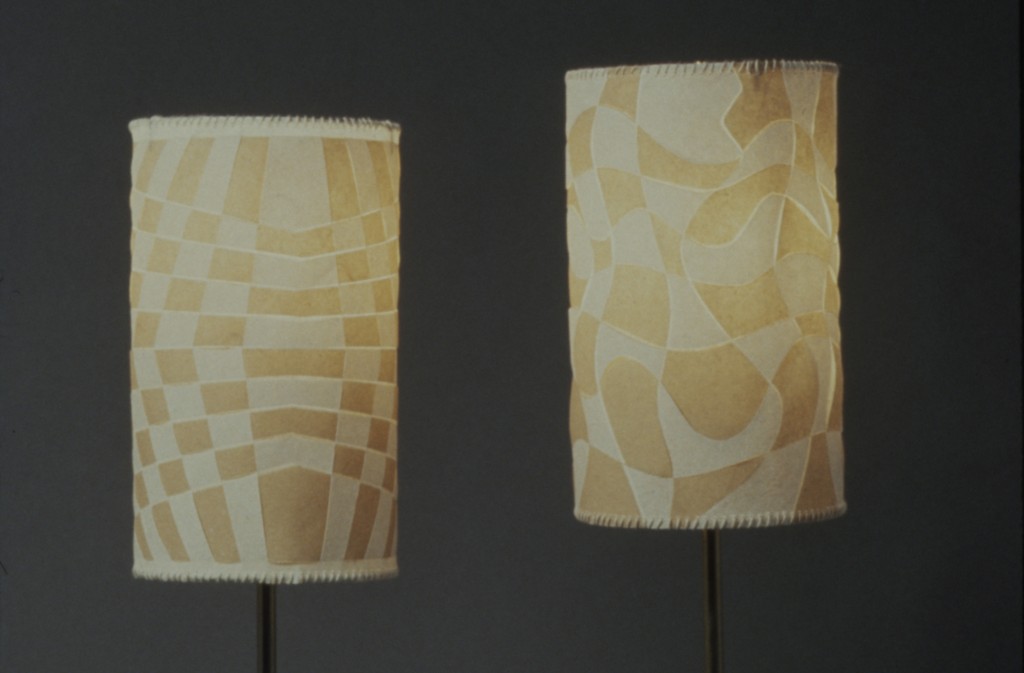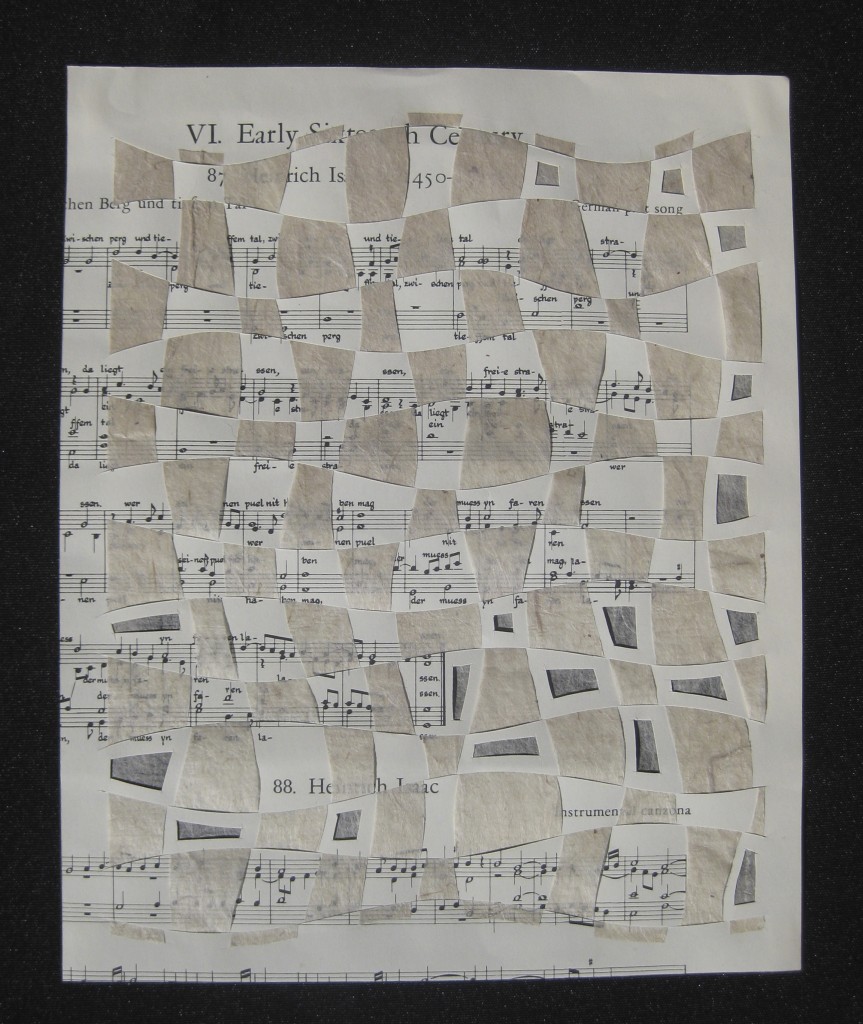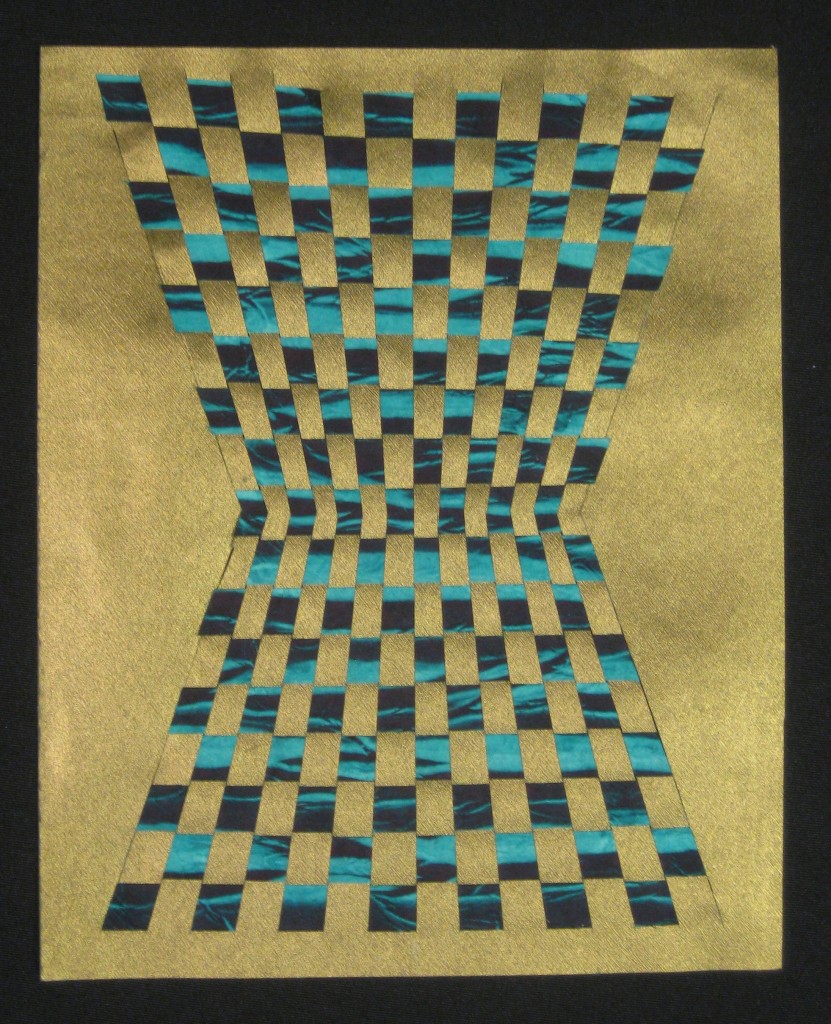By the Light of the Moon
The Morgan Conservatory of Art, a fantastic papermaking institution in Cleveland, Ohio, indirectly inspired the 100 x 100 Paper Weavings Project. Early this summer, they sent me two pieces of handmade paper and requested that I make a piece for their auction. After studying both papers, I decided that weaving would be a good way to join them, and the colors reminded me of moonlight.
I started thinking about the paper weavings I’ve done over the years, and there are some subtle nuances to be recognized and experimented with. Like this: look what happens to these woven lampshades when you turn the light on.
The two papers blend together and you don’t see any distinction. I find it really interesting that the space between the woven pieces (the paper slits) are highlighted by illumination.
Here are the latest 100 x 100 Paper Weavings:
#3
When I first posted about this project, artist Sarah Strong offered to send me some papers. I received a lovely package filled with encyclopedia pages, sheet music, German bible pages and a book about ships. I coupled this sheet music with a piece of my own handmade kozo paper.
Now I have to admit that despite a couple of workshops in Japanese papermaking, I am nowhere near expert status. I tend to agree with Malcolm Gladwell’s 10,000 hour rule and take solice in the fact that I have not performed my 10,000 hours with kozo.
That said, paper weaving can hide imperfection. If you look closely at this weaving, you can see that the paper fades from top to bottom. This is due to the fact that the sheet is thicker at the top than the bottom. If you are familiar with Japanese papermaking (this link is a video by Tatiana Ginsberg demonstrating the technique), you’ll understand how this could easily happen.
#4
When I was in Minneapolis a year or so ago, I had the pleasure of visiting Wet Paint, an art supply store in St. Paul, and perusing their fabulous paper selection. This weaving is a blend of two papers that I purchased there: crystal metal (which, by the way, was a challenge to photograph) and electric zigzag lokta Paper.
The lokta paper is made from the inner bark of the Nepalese Daphne plant. You can find lokta papers in a variety of solid-colors as well as printed patterns. This one is made by crumpling a large sheet until it is reduced to a two-inch square and then dipping selected points in dye. The crumpling also makes the paper very soft and cloth-like.
Today’s weaving utilizes the old photographic technique of van dyke printing. My friend and fellow Penland instructor Alyssa C. Salomon created these two prints on some of my handmade abaca paper. The bird stood alone on a white sheet and the grasses were printed on a green sheet. I decided to weave in a bamboo branch for hanging.
Update –Read more about the 2019 Weave Through Winter online class and register. Here’s my pinterest board featuring all 100 paper weavings!








12 Comments
I love how your lampshades turn even subtler when the light is on.
I know this isn’t a sophisticated choice, but I love the translucency of patterned vellum. I had one with tiny stars in it once. So pretty.
Janel, I love translucent papers too, of any variet (vellum, handmade, wax paper, you name it!)
These are marvelous Helen! Love watching your variety. BTW, Web Paint is a wonderful art store. I so liked going there when I lived in Minneapolis…..I miss it.
Thanks, Carol!
Favorite papers? Too many to name. Right now I am enjoying marbled papers I created on thin mulberry paper.
Janet, what a nice dilemma to have – too many favorite papers!
Before I was a papermaker, I was a weaver – so I am very intrigued with all the examples you are coming up with. It will be with great anticipation as we go through the entire series with you…
I have a book of braille if I can put my hand on it – and will send you some pages to play with. (Since I am packing for a move, things are not where they were – and I am sure you know what I mean with your recent moves.)
Banana is my favourite fibre to work with – and it is such a surprise to see all the many forms in appearance it can take, depending on the process and time spent at various stages of the process.
Keep surprising us, Helen! Mimi ♥
Mimi, I would LOVE the braille if you come across it, but totally understand if you don’t! Maybe it will be one of those happy accidents now that you’ve brought it up. Thanks, as always, for your kind words and best of luck with the move! I do know how stressful that is.
I so enjoy reading your posts. This weaving project brought back memories of when I used to weave paper as a child and again as an adult dabbling with what to do with the lovely Japanese paper (both mass and hand produced) that I had. You have inspired me to do so again. Once the floors in the house are done and I have my workspace back I will be able to spread out all the papers I have collected and be able to choose the ones with which I will be working. I am very much looking forward to that! I am also looking forward to your future posts in this and all other amazing projects.
Thanks, Jade. I’m glad this has been inspiring. It is equally inspiring to get feedback like yours Enjoy your “new” workspace.
[…] Here’s the blog post I wrote when I started that project, in which I describe the first paper weavings I did to kick off the 100 days + some stories about where I found the papers. […]
Great start on the 100 weavings project, Helen! Can’t wait to click the Pinterest tab to see the rest of them. Your work reminds me of my yarn-weaving days, back in middle school. Can’t wait to try it in paper again, as with construction paper in elementary school! Thinking I might feel like a kid again, once my fingers touch the paper and scissors. Did you cut the varied-width curvy cross-pieces with stencils? Hod did you get them to fit the slots?